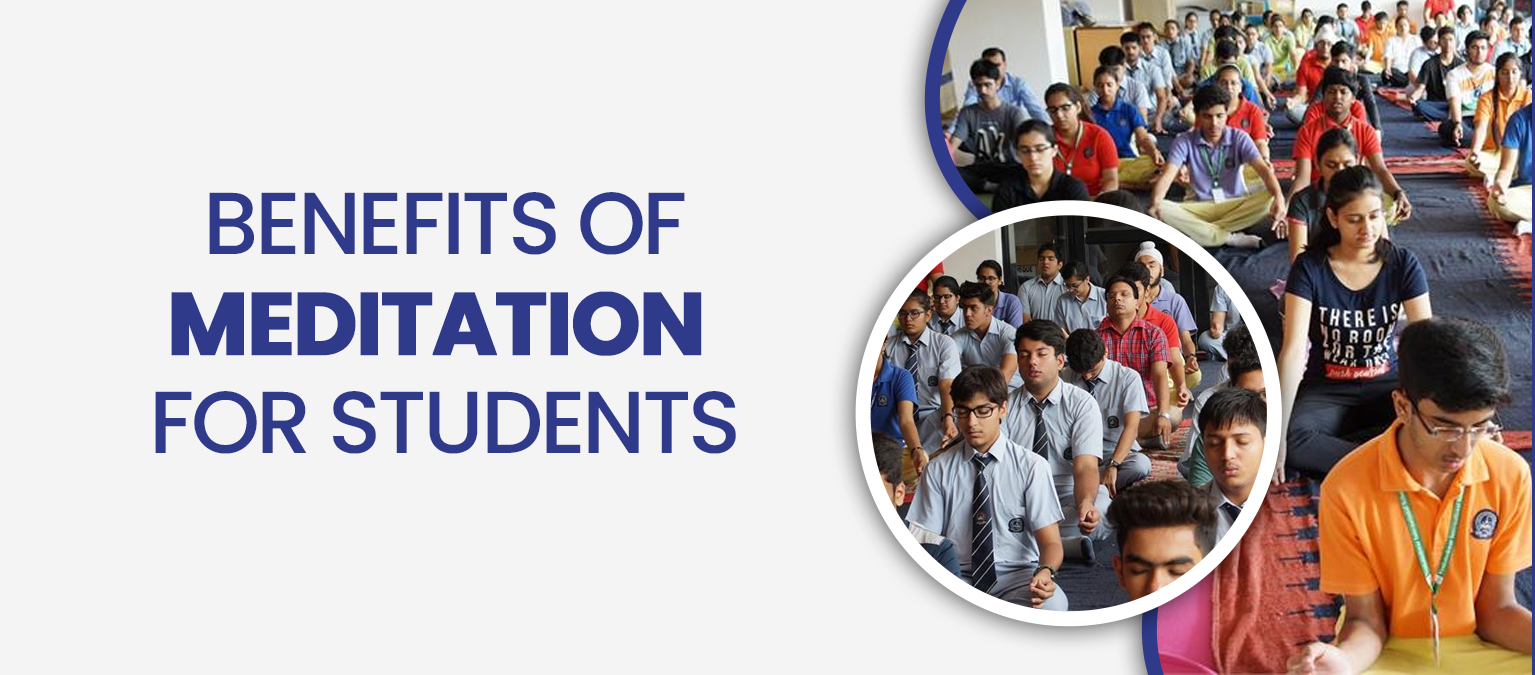Meditation in School Life: Boost Focus, Beat Stress, Sleep Better
May 10, 2023
Students today face academic stress, distractions, and emotional pressure. Learn how meditation can help improve focus, mental health, and overall wellness.

Benefits of Meditation for Students
The arrival of the 21st century has introduced numerous challenges for mankind, along with the huge technological leaps. For a student, the learning process is no longer confined to books and exams. They keep balancing between submitting the assignments, participating in extracurricular activities, and sustaining a healthy circle of friends. In the competition to reach the top, something or the other tends to get ignored—unfinished homework, skipping school for being tired, or even minor fights with friends.
The mind tends to wander, especially when faced with an important task. Add the constant buzz of mobile phones and social media, and the distractions only increase. This leads to reduced productivity and mounting stress. These rising challenges call for practical, accessible solutions that can nurture mental wellness for students and help them thrive—not just survive—through their academic years.
One such solution is meditation, which is increasingly recognized as a powerful tool in wellness activities for students.
Why Meditation Is So Important for Students Nowadays
Meditation is an old technique utilized for thousands of years to soothe the mind and produce inner calm. At present, it is at the focal point of mindfulness training for students and is gaining popularity in every age group, particularly among school students.
Students nowadays face great academic pressure, social anxiety, and information overload, which can have a great effect on their mental and emotional health. When applied to student health and wellness activities, meditation doesn't merely enhance academic achievement—it enhances emotional resilience, self-knowledge, and an increased sense of calm.
1. Decreases Stress and Anxiety
One of the key advantages of meditation is that it can alleviate stress and anxiety. When students are under pressure to work all the time, they get overburdened. Meditation relaxes them, calms the mind, and gives them clarity. As a component of guided mental wellness for students, meditation makes them better at managing emotional reactions and remain balanced.
2. Enhances Concentration
Distractions are everywhere—whether it’s social media notifications, noise, or even internal restlessness. Through regular meditation, students can train their minds to remain attentive and grounded. This is especially helpful in schools that prioritize mindfulness activities for students, where attention and presence are vital to both academic and co-curricular success.
3. Enhances Emotional Well-being
Emotional intelligence is equally vital as the cognitive abilities. Regular meditation, practiced by students, enhances self-awareness and regulation, ultimately leading to better emotional control. Meditation, as an activity in student wellness, enables students to control unpleasant emotions such as anger, sadness, or frustration in a positive manner, enhancing relationships and self-esteem.
4. Encourages Improved Sleep
Good sleep is necessary for energy, learning, and health. Nevertheless, many students have poor sleep patterns. Meditation, particularly before sleep, has the ability to soothe the mind, relax anxiety, and induce deeper sleep. Through this, it plays an important part in overall health and wellness exercises for students.
5. Enhances Creativity and Problem-solving Skills
A calm and concentrated mind is more receptive to new ideas. Meditation de-clutters the mind, allowing students to think critically and problem-solve with confidence. As students encounter varying challenges while pursuing their studies, this element is a dominant factor in mental well-being for students and all-around development.
Basic Meditation Techniques for Students
Meditation is not universal. Luckily, there are several different techniques that can be tried and followed by students according to their choice and routine. These practices provide a solid basis for successful mindfulness activities for students.
1. Mindful Breathing
This is one of the easiest and most potent methods to start meditation. Students may sit in a quiet corner, close their eyes, and watch their breath—gazing at inhale and exhale. When the mind wanders, they softly return their focus to breathing. This humble practice creates peace and enhances the attention span.
2. Loving-Kindness Meditation
The practice develops compassion and empathy, both for self and others. Students repeat, silently, such things as:
-
May I be happy
-
May I be healthy
-
May I be safe
-
May I live with ease
They then apply these blessings to others—friends, neutral persons, even those they might find difficult. This exercise develops emotional strength and compassion, and thus it is an important part of wellness exercises for students.
3. Walking Meditation
For those students who have difficulty sitting still, walking meditation is an excellent substitute. Through concentration on the feeling of their feet on the ground and the cadence of their steps, they are exercising mindfulness while in motion. This works particularly well when integrated into health and wellness exercises for students that stimulate body movement and mental acuity.
4. Visualization
Visualization urges the students to envision a calm environment—such as a beach, a mountain, or a serene forest. While they vividly imagine the setting with all their senses, they feel complete relaxation. The process is quite effective in easing performance anxiety and priming the mind prior to exams or public speaking.
In Conclusion
Adding meditation to students' everyday lives isn't a good-to-have; it's a must. It helps students achieve academically while promoting mental, emotional, and social well-being. When infused into student mindfulness activities, student wellness activities, or more general student health and wellness activities, meditation provides a holistic solution to developing students.
By starting small, just a few minutes a day, students can create powerful, lasting changes in their lives. These practices help them stay calm amidst chaos, focused amidst distractions, and resilient amidst challenges, unlocking not just better performance, but a better version of themselves.